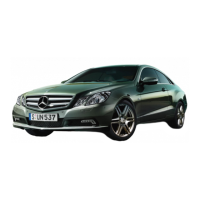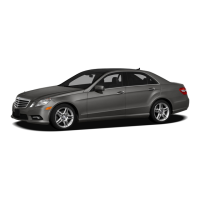Heavyand light loads
G
Risk of accident
Never depressthe brake pedal continuously
while the vehicle is in motion,e.g. never cause
the brakes to rub by applying constant slight
pedal pressure. Thiscauses the brake system
to overheat, increases the braking distance
and can lead to the brakes failing completely.
If the brakes have been subjected to aheavy
load, do not stop the vehicle immediately,but
drive on for ashort while. This allowsthe air-
flowtocool the brakes morequickly.
If the brakes have been used only moderately,
you should occasionally test their effective-
ness. To do this, brake more firmly from a
higher speed. This improves the grip of the
brakes.
Wet roads
If driving in heavy rain for aprolonged period
of time without braking, there may be a
delayed reaction from thebrakeswhen brak-
ing for the first time. This mayalso occur after
the vehicle has been washed.
You have to depress the brake pedal more
firmly. Maintain agreater distance from the
vehicleinfront.
After driving on awet road or havingthe vehi-
cle washed, brake firmlywhile paying atten-
tion to the traffic conditions. This will warm
up the brake discs, thereby drying them more
quickly and protecting them against corro-
sion.
Limited braking performance on salt
treated roads
G
Risk of accident
The layer of salt on the brake discs and the
brake pads/linings may cause adelay in the
braking effect,resultinginasignificantlylon-
ger brakingdistance, which could lead to an
accident.
To avoid this danger, you should:
R
occasionally brake carefully, without put-
ting other road users at risk, when you are
drivingonsalted roads. This helps to
remove any salt that may have started to
build up on the brake discs and the brake
pads/linings.
R
maintain agreater distance to thevehicle
ahead and drivewith particular care.
R
carefully apply the brakes at the end of a
trip and immediately after commencing a
new trip, so that salt residues are removed
from the brake discs.
New brake pads/linings
G
Risk of accident
New brake pads/liningsonly reach theiropti-
mum braking effect after severalhundred kil-
ometres of driving. Before this optimum brak-
ing effect is reached, you should compensate
for the reduced braking effect by applying
greater pressure when braking. This also
applies after the brake discs or the brake
pads/liningshave been replaced.
For safety reasons, Mercedes-Benz recom-
mends that you only have brake pads/linings
fitted to your vehicle which have been
approved for Mercedes-Benz vehicles or
which correspond to an equivalent quality
standard. Brake pads/liningswhich havenot
been approved for Mercedes-Benz vehicles or
which arenot of an equivalent quality could
affect your vehicle'soperating safety.
Tyre traction
G
Risk of accident
Whilethe vehicle can be fully controlled at a
certain speed on dry roads, you must reduce
your speed on wet or icy roads to achieve the
same road safety. Otherwise, you could cause
an accident.
Pay particular attention to the road conditions
at temperatures around freezingpoint.
Driving tips
155
Driving and parking
BA 207ECE ÄJ 2010/1a; 1; 2, en-GB
mkalafa Version: 3.0.2.11
2010-01-26T13:03:22+01:00 -Seite 155
Z

